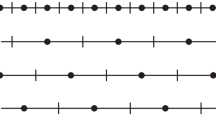Abstract
A class of singularly perturbed two-point boundary-value problems (BVPs) for second-order ordinary differential equations (DEs) is considered here. In order to obtain numerical solution to these problems, an iterative non-overlapping domain decomposition method is suggested. The BVPs are independent in each subdomain and one can use parallel computers to solve these BVPs. One of the characteristics of the method is that the number of processors available is a free parameter of the method. Practical experiments on a Silicon Graphics Origin 200, with 4 MIPS R10000 processors have been performed, showing the reliability and performance of the proposed parallel schemes. Error estimates for the solution and numerical examples are provided.
Similar content being viewed by others
References
R. E. O'Malley. Singular Perturbation Methods for Ordinary Differential Equations, Springer Verlag, New York, 1991.
E. P. Doolan, J. J. H. Miller, and W. H. A. Schilders. Uniform Numerical Methods for Problems with Initial and Boundary Layers, Boole Press, Dublin, Ireland, 1980.
H.-G. Roos, M. Stynes, and L. Tobiska. Numerical Methods for Singularly Perturbed Differential Equations, Springer, Berlin, 1996.
J. J. H. Miller, E. O'Riordan, and G. I. Shishkin. Fitted Numerical Methods for Singular Perturbation Problems, World Scientific, Singapore, 1996.
S. M. Roberts. A boundary-value technique for singular perturbation problems. Journal of Mathematical Analysis and Applications, 87:489–508, 1982.
P. A. Farrell. Sufficient conditions for uniform convergence of a class of difference schemes for a singular perturbation problem. IMA Journal of Numerical Analysis, 7:459–472, 1987.
J. Vigo-Aguiar and J. M. Ferrándiz. A general procedure for the adaptation of multistep algorithm to the integration of oscillatory problems. SIAM Journal on Numerical Analysis, 35(4):1684–1708, 1998.
M. Garbey. A Schwarz alternating procedure for singular perturbation problems SIAM Journal on Scientific Computing, 17(5):1175–1201, 1996.
S. Natesan, J. Vigo-Aguiar, and N. Ramanujam. A numerical algorithm for singular perturbation problems exhibiting weak boundary layers. Computers & Mathematics with Applications, 45:469–479, 2003.
R. B. Kellogg and A. Tsan. Analysis of some difference approximations for a singular perturbation problem without turning points. Mathematics of Computation, 32:1025–1039, 1978.
S. Natesan and N. Ramanujam. Improvement of numerical solution of self-adjoint singular perturbation problems by incorporation of asymptotic approximations. Applied Mathematics and Computation, 98:119–137, 1999.
S. Natesan and N. Ramanujam. A computational method for solving singularly perturbed turning point problems exhibiting twin boundary layers. Applied Mathematics and Computation, 93:259–275, 1998.
Rights and permissions
About this article
Cite this article
Vigo-aguiar, J., Natesan, S. A Parallel Boundary Value Technique for Singularly Perturbed Two-Point Boundary Value Problems. The Journal of Supercomputing 27, 195–206 (2004). https://doi.org/10.1023/B:SUPE.0000009322.23950.53
Issue Date:
DOI: https://doi.org/10.1023/B:SUPE.0000009322.23950.53




